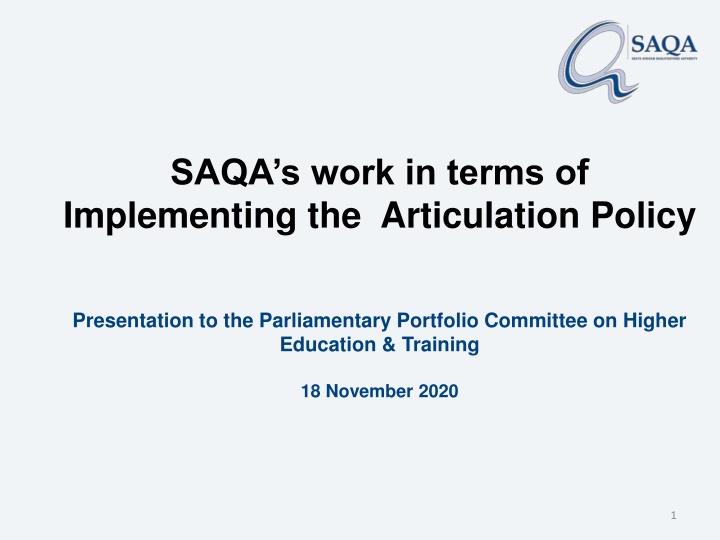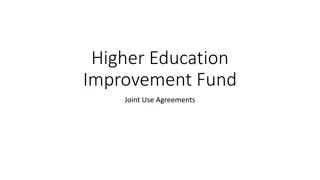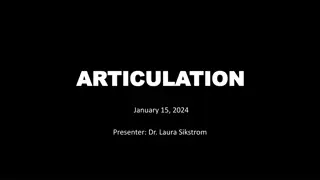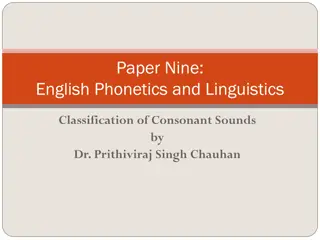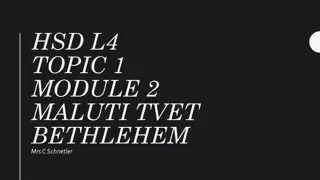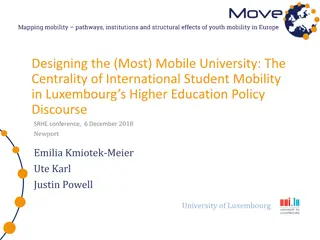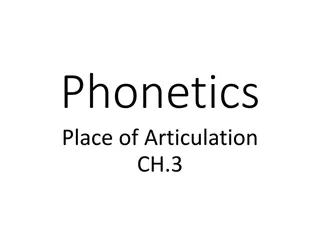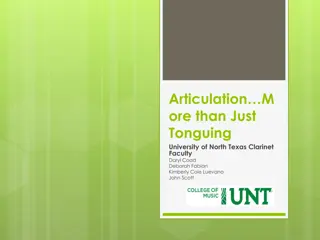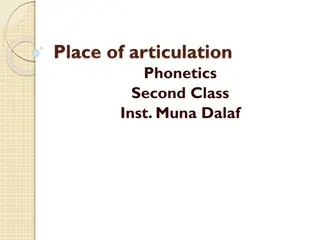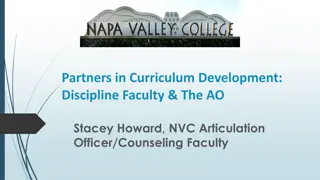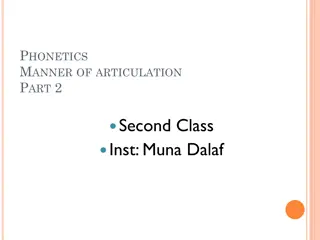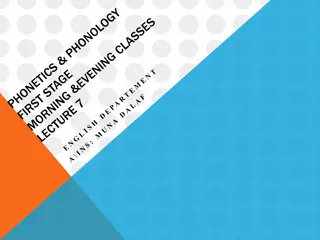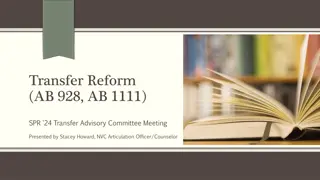SAQA's Role in Implementing the Articulation Policy in Higher Education
SAQA presented progress made in implementing the Articulation Policy to the Parliamentary Portfolio Committee on Higher Education & Training. The policy aims to create linkages within the South African post-school education system. SAQA's responsibilities include setting criteria for articulation, coordinating Quality Councils, and ensuring qualifications have articulation statements. They have made strides in aligning policies, reviewing the 2014 CAT Policy, and providing input into RPL and CAT policies. The goal is to enhance entry and progression requirements nationally.
Download Presentation

Please find below an Image/Link to download the presentation.
The content on the website is provided AS IS for your information and personal use only. It may not be sold, licensed, or shared on other websites without obtaining consent from the author.If you encounter any issues during the download, it is possible that the publisher has removed the file from their server.
You are allowed to download the files provided on this website for personal or commercial use, subject to the condition that they are used lawfully. All files are the property of their respective owners.
The content on the website is provided AS IS for your information and personal use only. It may not be sold, licensed, or shared on other websites without obtaining consent from the author.
E N D
Presentation Transcript
SAQAs work in terms of Implementing the Articulation Policy Presentation to the Parliamentary Portfolio Committee on Higher Education & Training 18 November 2020 1
Presentation overview Purpose 1 2 Background information 3 Responsibilities of SAQA Progress made by SAQA 4 2
1.Purpose To report on the progress made by SAQA in implementing the 2017 Articulation Policy for the Post- School Education and Training System of South Africa 3
2.Background information The Articulation Policy establishes the overarching conceptual structure, principles and policy statements to support the implementation of credible approaches to articulation within the South African post-school education and training system Minister: HEST published the Articulation Policy in 2017 a well -articulated system is one in which there are linkages between its different parts; there should be no silos, no dead ends. Learners must be supported in their individual learning and work pathways 4
3. Responsibilities of SAQA 3. Responsibilities of SAQA Determine criteria for Articulation Co-ordinate the work of QCs to eliminate Articulation conflicts Ensure that all qualifications have Articulation statements Provide leadership to QCs in terms of Articulation processes and practices Advise the Minister about amendments to legislation/policy Resolve systemic challenges and incongruities Provide annual reports to the Minister 5
4. SAQAs Progress in terms of its Responsibilities a. Determine criteria for articulation SAQA has encouraged the QCs to align their policies to the revised national policies. In this regard, SAQA made extensive inputs into the Quality Council for Trades and Occupations CAT revised policy in June 2020. The QCTO s CAT Policy, when published, should be aligned to SAQA s revised CAT policy and the DHET s Articulation Policy. Reviewed the SAQA 2014 Credit Accumulation and Transfer (CAT) Policy in 2020 to align it to the Articulation Policy. The CAT Policy will be published on 23 November 2020 for public comment. The reviewed policy will be gazetted in March 2021. By 31 March 2021, the QCs must ensure that institutional policies include national entry and progression requirements, and post- qualification pathways, in line with SAQA and DHET policies Inputs into Umalusi s (a) revised Recognition of Prior Learning (RPL) and CAT policies in February 2020, (b) articulation for the new General Education Certificate (GEC) in the General and Further Education and Training Qualifications Sub-Framework of the National Qualifications Framework (GFETQSF), and (c) as part of the Technical Working Group for the Department of Basic Education s Ministerial Task Team, towards articulation in the new Three Stream Model for Basic Education. Inputs into the Council on Higher Education s Norms and Standards for Certification for the Higher Education Sector in the Context of the Higher Education Qualifications Sub- Framework (HEQSF) , published in 2020, in which RPL and CAT feature in a way that is broadly aligned to SAQA and DHET Recognition of Prior Learning (RPL), CAT and Articulation Policies. Participating in the CHE s Task Team to enhance articulation between TVET and Higher Education. The alignment of the CHE policies for RPL and CAT is under discussion 6
b. Ensure that that all new qualifications, and those submitted for re- registration, have statements about articulation SAQA has identified 74 Higher Education qualifications already registered on the NQF after 1 January 2014 that do not have an articulation option, and requested the missing information from the Council on Higher Education (CHE). So far, the CHE has submitted eight (8) qualifications and SAQA has processed them. SAQA revised its Policy and Criteria for Registering Qualifications and Part- Qualifications on the NQF, to provide for these aspects. The revised policy was published via Government Gazette in March 2020. During the 2020/2021 financial year, all qualifications registered on the NQF comply with the registration requirements. SAQA returns qualifications with no articulation pathways to the QCs for amendments. SAQA made inputs into the Umalusi Policy and Criteria for the Development, Registration and Publication of Qualifications on the General and Further Education and Training Qualifications Sub-Framework of the National Qualifications Framework. The aim was to ensure that, when the policy is published, it is aligned with the SAQA Policy and Criteria for Registering Qualifications and Part- Qualifications on the NQF in terms of Articulation. SAQA designed the 2021 NQF Impact Study to focus on the implementation and impact of the national policies for RPL, CAT and system flexibility. SAQA will complete this study and publish its findings by March 2023. 100% of qualifications registered by SAQA have at least one horizontal and vertical articulation option. Surveyed 500 stakeholders; Extended deadline until December 2020 to increase responses. A preliminary analysis was conducted in August 2020, of the responses relating to CAT the results were circulated within SAQA in September 2020, and informed SAQA s CAT policy review process and inputs. 7
d. Provide annual reports to the Minister, after consultation with the QCs, about the implementation of articulation across the education and training system The Articulation Policy requires SAQA to report to the Minister: Higher Education, Science and Technology (HEST) on the National Qualifications Framework (NQF) family's progress with implementing it. The CEO Committee set up a task team comprising SAQA, the DHET and the QCs, to develop a reporting template for this purpose. The Task Team developed a draft Theory of Change for the Articulation Policy, which provided the framework for the report. In the report, each specifies how it will contribute to the outputs and outcomes, and provide its delivery deadlines. Each entities reports its progress against clear deliverables. SAQA consolidated the first annual report to the Minister (HEST) and submitted it in April 2020. The second report will be submitted in April 2021. 8
e. Resolving systemic challenges and incongruities as they occur; address deficiencies so as to produce a well-articulated system that brings The problems with articulation within occupational qualifications and part-qualifications are the following: One of the biggest challenges for articulation of qualifications across the two sub-frameworks is the development of Exit Level Outcomes (ELOs). ELOs within occupational qualifications reflect occupational tasks which are not framed against the level descriptors. DRR is in the process to develop a guideline document to assist the developers of qualifications in the development of ELOs to ensure better articulation between qualifications within and across sub- frameworks. The Policy and Criteria for the Registration of Qualifications and Part- qualifications on the NQF (As amended 2020) requires that Quality Councils (QCs) must indicate horizontal, vertical and diagonal articulation options when recommending qualifications for registration on the NQF. The Quality Council for Trades and Occupations (QCTO) develops Occupational qualifications and part-qualifications from levels 1 to 8 and recommend it for registration on the NQF. Meetings with QCTO, the Development Quality Partners (DQPs), Assessment Quality Partners (AQPs) and Qualification Development Facilitators (QDFs) to discuss issues relating to articulation of occupational qualifications with qualifications registered on the HEQSF. i) Part-qualifications with credits less than 120 articulate to qualifications registered within the OQSF and HEQSF with 120 credits or more. ii) Qualifications) with less than 120 credits articulate to qualifications registered within the OQSF and HEQSF with 120 credits or more. iii) Articulation options are considered within and across sub- frameworks without considering the entry requirements of the qualifications to which it articulates. iv) Occupational qualifications articulate to historical qualifications that expired or are about to expire. v) HEIs do not accept occupational qualifications for entry to their qualifications. 9
f. Advice given to the Minister by SAQA DETERMINATION OF THE SUB-FRAMEWORKS THAT COMPRISE THE NATIONAL QUALIFICATIONS FRAMEWORK Advised on Levels and Qualification Types Exceptions Transitional Arrangements 10
g. Co-ordinate the work of QCs and eliminate conflicts (1) Simplifying the NQF CEO Committee engagement towards addressing articulation jointly across SAQA and the Quality Councils (NQF Sub- Frameworks) Process to align all higher education qualifications including legacy qualifications with the HEQSF Process to align legacy occupational qualifications with the OQSF Registering qualifications at NQF Level 5 (e.g. Higher Certificates) that help to bridge across the NQF Sub- Frameworks Collaboration between NQF partners and with NQF stakeholders Providing NQF advice, advocacy, communication 11
Research and developments that have deepened articulation (2) SAQA research and development Learning-and-work pathways for sustainable development Understanding TVET College lecturers Developing an inclusive RPL model Strengthening learning pathways in Community Development, ECD, Engineering Articulation between TVET, higher education and the workplace Flexible Learning and Teaching Practices (FLTP) Case Study on Flexible Learning Pathways (FLPs) in South Africa NQF Impact Studies 12
Project: Understanding TVET College lecturers The research looked at: who TVET College lecturers are, what education and training they have, what languages they speak, how they teach SAQA partnership research 2009 2012 TVET College lecturers are agents of articulation Main impact: Research fed into the DHET s Policy on Professional Qualifications for Lecturers in TVET Main outputs: (1) SAQA Bulletin 2015 and (2) policy inputs 13
Project: Learning-and-work pathways for sustainable development The research looked at: how learning-and work pathways are taking place in emerging sustainable development areas, and how to strengthen such pathways Focus: (1) Understanding learning-and-work pathways and (2) developing learning- and-work pathways in emerging fields SAQA partnership research 2009-2011 + 2012-2015 Main impact: Led to the development of actual pathways _ informed all further articulation research and development by SAQA Main outputs: (1) Summary report, (2) SAQA Bulletin 2017, (3) actual development of learning pathways 14
Project: Developing an inclusive RPL model The research looked at: Understanding inclusive RPL processes and developing an RPL model applicable across a wide range of contexts RPL for (a) access to undergraduate studies, (b) access to postgraduate studies, (c) workplace contexts, (d) in Worker Education SAQA partnership research 2009 2015 Main impact: (1) informed national RPL policy development in 2013, 2016, 2019, (2) informed Quality Council RPL policies, (3) informed the implementation of RPL across the country Main outputs: One of three peer reviewed RPL books in the world, and deepened RPL practices in the sectors involved 15
Project: Flexible Learning and Teaching Practices (FLTP) The project involved: using action research to develop FLTP at a public HEI that serves poor and working class students SAQA partnership research 2012-2015 Main outputs: Main impact Actual FLTP that have persisted since the project deep and lasting transformation in one public HEI deep sharing of the research with all public HEIs, USAf, CHE/ across-HEI learning a booklet on the project informed all SAQA s further articulation research and development a poster on the project 16
Project: Articulation between TVET, higher education and the workplace SAQA partnership research 2016- 2020 The project involved Main outputs Main impact knowledge and understanding of articulation that exists in the country and how it works the National Articulation Baseline Study National Articulation Baseline Study Report formed the basis of, and provided support for, SAQA s initiative to strengthen learning pathways in Community Development, Early Childhood Development, Engineering and other sectors identifying existing articulation initiatives Set of Articulation Enablers developing a set of articulation enablers towards taking successful initiatives to scale Booklet on the whole project developing actual articulation via action research in seven case studies Actual articulation in the context of the seven case studies 17
Project: Strengthening learning pathways in Community Development, ECD, Engineering September 2018 September 2019 May 2019 2020 -2022 2022/23 SAQA convened sector leaders, identified specific sectoral articulation challenges, sketch plans to address SAQA convened sectoral meetings to add detail to and fine-tune the plans SAQA hosted the 3rd NQF Conference Strengthening learning pathways in , CD, ECD, Engineering articulation plans were shared, improved, adopted with around 200 stakeholders SAQA, the Quality Councils, the professional bodies concerned, and sector leaders and stakeholders implement the plans 4th NQF Conference to report back on the plans implemented 18
Project: Case Study on Flexible Learning Pathways (FLPs) in South Africa May 2019-June 2022 UNESCO identified eight countries with strong articulation initiatives/ FLPs The research included Main outputs Chile, Finland, India, Jamaica, Malaysia, Morrocco, South Africa, UK UNESCO s international survey Country report (2) eight country case studies that (a) documented national FLP policies, tools and practices, and (b) captured national and institutional views on what is being done re FLP/ articulation short paper the enablers and barriers (South African study: 51 interviews with 80 people) policy brief webinar and information- sharing 19
Project: NQF Impact Studies 2014 NQF Impact Study 2017 NQF Impact Study 2021 NQF Impact Study Focused on the implementation and impact of (1) SAQA s policies for RPL, CAT and assessment, (2) the NQF Level Descriptors, (3) NLRD tools, (4) the integration of public + private HE, (5) the QCTO model all of which link directly to articulation (SAQA, 2019) Focused on the system s progress regarding access, redress, progression (articulation), quality, transparency (SAQA, 2017) Focuses on the impact of RPL, CAT and FLP policies across all NQF stakeholders (SAQA, 2021/22 forthcoming 20
Some short-term research linked to articulation.. The possibilities of Convener System under the NQF (2011) SAQA as RPL cases (2010- 2015) Articulation Ombud (2016) Understanding learning pathways (2017) Worker Education (2015) RPL in SETAs (2012) Criteria and processes for registering qualifications (2012) Continuing Professional Development (CPD) (2015) Elaborating on successful articulation initiatives (2018) Overlaps in legislation for NQF, SAQA, QCs, PBs (2020) Learning pathways in the EW sector (2015) Learning pathways in Community Development (2015) Sustainable professional bodies (2019) 21
Getting articulation research/ development into policy and practice (GRIP) Advice to the Minister Events Publications 22
Revised NQF: SAQAs Advice to Minister: HEST NQF Sub- Framework/ Quality Council NQF Sub- Framework/ Quality Council NQF Level NQF Sub-Framework and Qualification Type Doctoral Degree Doctoral Degree (Professional) Higher Education Qualifications Sub-Framework (HEQSF)/ 10 Master s Degree Master s Degree (Professional) Council on Higher Education (CHE) 9 Occupational Qualifications Sub-Framework (OQSF)Quality Council for Bachelor Honours Degree Post Graduate Diploma Bachelor s Degree Specialised Occupational Diploma 8 Bachelor s Degree Advanced Diploma Advanced Occupational Diploma 7 Trades and Occupations (QCTO) Diploma Advanced Certificate Occupational Diploma 6 Higher Certificate Higher Occupational Certificate 5 General and FurtherEducation and Framework (GFETQSF)/Umalusi National Occupational Certificate National Certificate 4 TrainingQualifications Sub- Intermediate Occupational Certificate Intermediate Certificate 3 Elementary Occupational Certificate Elementary Certificate 2 General Occupational Certificate General Certificate 1 24
National Articulation Baseline Study Articulation initiatives found in the National Articulation Baseline Study (SAQA, 2018) 26
Reported articulation Developed articulation scenarios Emerging articulation scenarios Latent articulation scenarios Not sure Total no. of articulation scenarios Institution type HEIs 8 9 7 1 25 TVET Colleges 8 29 13 0 50 Total no. of articulation scenarios 16 38 20 1 75 27
Articulation enablers Focusing on particular pathways (highways) at a time Collaborative relationships Career advice Advocacy + use of NQF regulatory system Quality teaching & learning Critical resources Creation + commitment to MoU/MoA Inclusive admission criteria Articulation research 28
Recently Analysis of overlaps in legislation for the NQF, SAQA, the Quality Councils and statutory professional bodies Technical Working Group for the DBE s Ministerial Task Team on Articulation in the Three Stream Model for Schools CHE Task Team to enhance articulation between TVET and higher education 32
